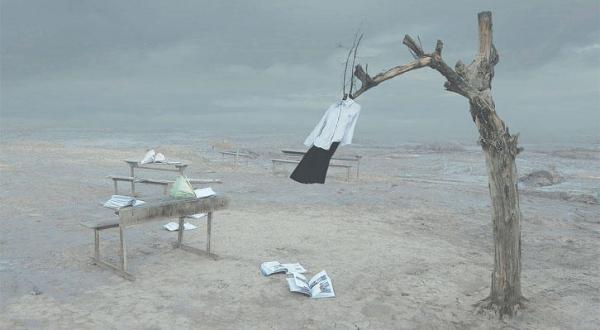The Iraqi Fine Artists Association – UK, organized its second Conceptual Art exhibition at the Greenside Hall in London. Ten artists from Iraq, Syria, and the United Kingdom participated in the exhibition. The themes of the conceptual pictures varied to deliver the artists’ ideas and point of views to visitors.
The closest example that emphasized the conceptual art is “One and three chairs”, for the American artist Joseph Kosuth, composed of a wooden chair, a photograph of the chair, and the lingual definition, which the artist has presented with a magnified readable format, leading the viewer to feel a hard confusion in understanding the real concept of the chair.
The conceptual artist doesn’t capture its picture directly from nature or from vivid/static figures. Yet he has to devote himself for the idea and to work on its content for a sufficient duration to extract a theme that could be understood by the reader. The “Disassociating” photo by the photographer Hussein al-Kafi might be the closest example on the expressive conceptual photo.
It is composed of only three elements: the book “History and Class Consciousness” which represents the background of the photo, and a screwdriver on the right of the cover, and an adjustable spanner on its left. Both mentioned tools are used to dismantle and associate, but, Skafi aims to refer the reader to the importance of dismantling element in reading intellectual, philosophical, and religious books so we can avoid absurdity and the danger of interpretation at the same time.
Photographer Zainab al-Fekaiki has focused on the idea of “existence” despite the disability of the person sitting on the chair in her photo. The latter’s exit from a library proves that he strongly exists in the deepest joints of life, which are culture and knowledge.
The photographer Athir Dawood has chosen “The Parliament” as an idea for his conceptual work. The place in the picture is obscure, perhaps a basement, yet, the photographer refers his reader to the Iraqi parliament. All people talk at the same time without seeing or hearing anything, while an empty chair is placed in the middle, surrounded by six parliamentary figures, which are similar in everything. This empty chair might be highlighting the absence, death, or discharge of the president in the minds of the viewers.
The most mature among the Iraqi works is “Education Desertification” for the photographer Mohannad Hasan. This work features a dry tree with one of its branches handling a black skirt and a white shirt, in addition to five wooden seats scattered, a number of books opened on the seats and on the ground. On the other hand there are no trace for students in the photo, except for the feminine costume hanged on the left branch of the dry tree.
The building of the conceptual photo depends on specific conditions, mainly the abstention of composing elements, which dominates the theme on the expense of the form. The conceptual art emerges from the “minimalism”, which is based on a minimum of elements and dispenses many additional details that burden the work and confuse its visual language. Therefore, the ten conceptual pictures inclusion for few elements is not a surprising factor. Yet the pictures still enjoy a strong building with some surreal touches.
